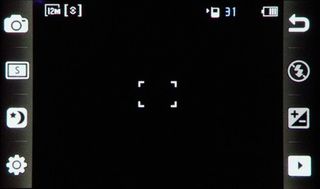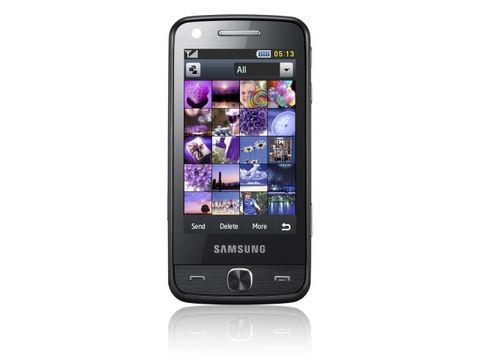Why you can trust TechRadar
As you might have guessed, the Samsung Pixon 12 M8910 is fairly camera orientated, and justifiably so. It's here that the phone comes into its own as it moves seamlessly from a mobile to a very good alternative to a point and shoot.

The sheer range of options on offer might be a bit less exciting than usual, simply because they've been used on a number of cameraphones recently, mostly from LG, Samsung and Sony Ericsson.

The Pixon 12 was one of the best we've seen thus far (along with the LG Viewty Smart) simply because it managed to make the most of nearly all the settings.
It also packed a new feature we haven't seen on Samsung cameraphones yet: Smart Auto (you may remember a similar thing from LG on the Viewty Smart, although it was called something very different: Intelligent Auto).
This basically allows you to take pictures without having to worry about settings, making sure you got the best possible picture time after time, which is especially useful if you need to snap quickly. In fact, when picture preview is turned off the speed with which you can take another picture is mind-blowing - around a second or so even at 12MP resolution.
Some options are more useful than others though: things like Smile Shot are really nothing more than a gimmick - we don't know any friends that like to smile as widely and as toothily as is needed to activate the smile sensor and take a picture. To be honest, the only way this mode would be worth anything is if a sensor could measure hormones and tell if someone is genuinely happy before grinning.
The blink detection generally managed to work out when there was a problem with closed eyes, although it managed to get it wrong on occasion. Similarly beauty mode seemed to make very little difference (close ups showed a very slight sheen over the top of slight flaws in subject's faces) but then again, we may just be blessed with very beautiful friends already...
Here's how the Samsung Pixon 12 M8910 compared to our pro-sumer 10MP Olympus SP-565UZ camera effort:
The Pixon 12 M8910:

Under normal lighting conditions (in the depths of darkest Portsmouth) the Pixon 12 M8910 performs equally as well as the Olympus, with detail and colour equally well observed.
The Olympus SP-565UZ:

The Pixon 12 M8910:

In direct light, the Pixon 12 M8910 surprisingly suffers with light bleeding into the shot, whereas the Olympus manages to eradicate it quite easily.
The Olympus SP-565UZ:

The Pixon 12 M8910:

Both the Samsung Pixon 12 and the Olympus perform very well in macro mode, using the flash to capture close up detail.
The Olympus SP-565UZ:

The Pixon 12 M8910:

In fairness, we're comparing a digital zoom from the Samsung Pixon 12 with an optical zoom on the Olympus, and the difference isn't too bad.
The Olympus SP-565UZ:

The Pixon 12 M8910:

In sports mode, the Olympus makes the subject look like he's not actually moving, when he was actually in full motion. The Pixon 12 does a good job of centring on the subject, but still shows a lot of motion blur.
The Olympus SP-565UZ:

The Pixon 12 M8910:

Both cameras work pretty well with the light behind the subject, although the Pixon 12 M8910 struggles to show surrounding detail, while the Olympus manages it fairly easily.
The Olympus SP-565UZ:

The Pixon 12 M8910:

The Xenon flash on the Olympus easily outclasses the Pixon 12 in terms of overall light coverage, although the Samsung effort does highlight the important elements of the photo, but brings a slight halo effect.
The Olympus SP-565UZ:

Picture editing
There are a number of ways to edit pictures on the Samsung Pixon 12 M8910, and some are actually fairly useful before transferring to a PC. For instance, you can adjust the brightness and contrast on the photos automatically, and this seems to actually make a difference to your snaps.
However, there's also the option for 'photo eraser', which asks you to map out an area of the screen and then proceeds to do... something to it. Mapping out the area was difficult enough without a stylus, and the effects were just a bit weird, seeming to take elements of all the surrounding area and crushing them into the chosen area. Like we said, we're not sure of the point here.
There's also the option to draw on your photos, which is always good to add some glasses or a pair of devil horns onto your friends. However, we guess you'll use this feature a couple of times when you buy the phone, then get bored of it pretty quickly.
Video recording
Video recording on the Samsung Pixon 12 M8910 is pretty good indeed, thanks to 30fps VGA resolution. It's certainly not up there with the quality on the Samsung i8910HD or even the Samsung Tocco Ultra Edition, but it's certainly similar in quality to the iPhone or similar.
We were sad to note that while the QVGA 120fps recording was present (which is a fun novelty, albeit a pretty low resolution one), there was no 8x or 16x super-fast speed recording, as that's where the fun videos can be found. But the Pixon 12 M8910 is very much about the camera, and the camcorder has obviously been shunted in as an afterthought (although a very functional one indeed, and one that will be more than enough to upload to YouTube).
Add to that the fact Samsung has solved the eternal dilemma of 'Xenon flash = no video light' by simply putting another flash on there, and this gets a more than acceptable tick in our book.
Current page: Samsung Pixon 12 M8910: Camera
Prev Page Samsung Pixon 12 M8910: Internet Next Page Samsung Pixon 12 M8910: Media
Gareth has been part of the consumer technology world in a career spanning three decades. He started life as a staff writer on the fledgling TechRadar, and has grown with the site (primarily as phones, tablets and wearables editor) until becoming Global Editor in Chief in 2018. Gareth has written over 4,000 articles for TechRadar, has contributed expert insight to a number of other publications, chaired panels on zeitgeist technologies, presented at the Gadget Show Live as well as representing the brand on TV and radio for multiple channels including Sky, BBC, ITV and Al-Jazeera. Passionate about fitness, he can bore anyone rigid about stress management, sleep tracking, heart rate variance as well as bemoaning something about the latest iPhone, Galaxy or OLED TV.

